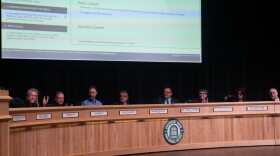Second of five stories on renewable energy in California
California Gov. Arnold Schwarzenegger has set an ambitious plan that requires a third of the state's electricity to come from renewable sources by 2020. But a fight over where to build large clean-energy projects is slowing the green revolution.
One of these battlegrounds is Panoche Valley, ringed by rolling, scrub-covered hills. Located in California's rural San Benito County, the area was used mostly for cattle grazing, and it has escaped the notice of many Californians. Until now.
Michael Peterson, CEO of Solargen Energy, was drawn to this slice of Central Valley ranchland because it gets almost as much sun as the scorching Mojave Desert. This valley seemed less controversial than the Mojave, which has become a nightmare for many solar entrepreneurs because of its protected national monuments and desert tortoises. For Peterson, the Panoche Valley seems perfect for large solar projects.
"When we had an engineer come who'd built a lot of different solar [projects] around [the region], we took him down to the property. And his comment was, 'Wow. God made this to be a solar farm,' " Peterson says, laughing.
Peterson wants to build one of the nation's biggest solar facilities of its kind. It would power about 120,000 homes. Another benefit of the project: Huge transmission lines already run right through Panoche Valley, making it unnecessary to build costly new power lines.
"It's key. It's everything," he says. "If you don't have it, the land is only as good as the ability to connect to the power."
Facing Environmental Critics
So far, five cattle ranchers have agreed to sell their land to Peterson's company, but not everyone thinks Solargen's plan is such a green idea.
"They would like to build an industrial project that extends the entire length of the valley," says Kim Williams, who moved to the Panoche Valley about four years ago to run an organic egg business called Your Family Farm. "Once you take the vegetation off the soil, the high winds are just going to be whipping up the topsoil and creating dust."
Williams is among several critics, including local chapters of the Audubon Society, that say the project would ruin the character of the valley and harm wildlife. Hints of lawsuits and requests to extend the environmental review process by some of these critics have slowed down Solargen's application.
It turns out this valley floor is teaming with creatures — some of them, like the blunt-nosed leopard lizard, are endangered. Solargen's investors have spent more than $7 million gathering information for a required environmental impact report. They have hired more than 20 biologists to conduct wildlife surveys.
Solargen has offered to buy another 11,000 acres adjacent to the proposed solar array. The idea is that animals, threatened by the project, could relocate to this land. But critics like Williams don't buy that argument.
"It would be impossible to ask the animals living on the floor to just move," Williams says.
Time Running Out
Similar debates over land use are playing out across California, and that has created a juggernaut of big solar and wind proposals — more than 200 are waiting approval. Michael Picker, the governor's renewable energy adviser, is trying to hurry the process in order to obtain billions of dollars in subsidies.
"Everybody wanted to step up the pace in order to capture these federal stimulus dollars and to leverage the private investment from banks and from other kinds of investment," he says.
But time is running out — to qualify, projects must break ground before the end of this year.
Copyright 2023 KQED. To see more, visit KQED. 9(MDAzMjM2NDYzMDEyMzc1Njk5NjAxNzY3OQ001))





